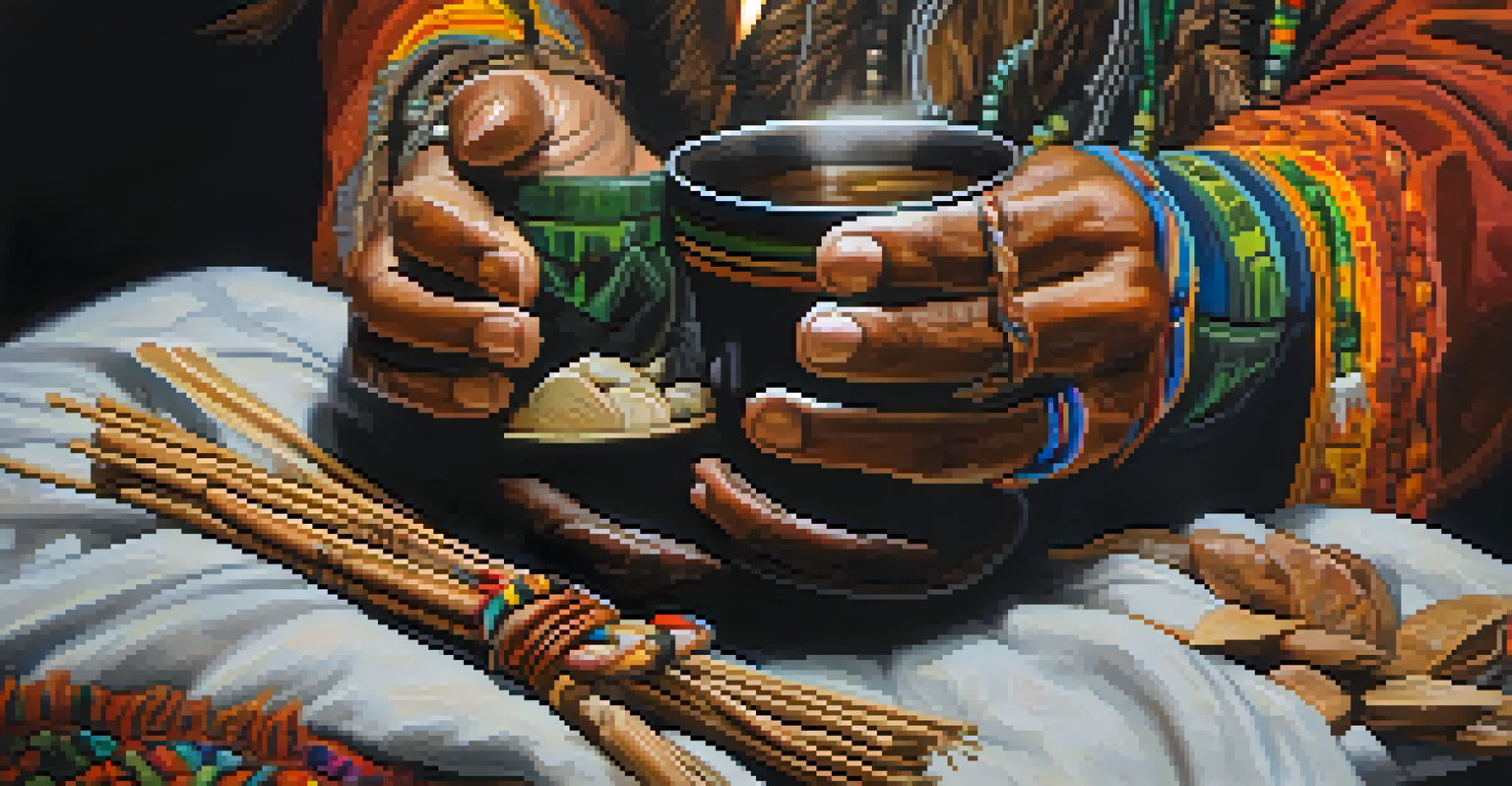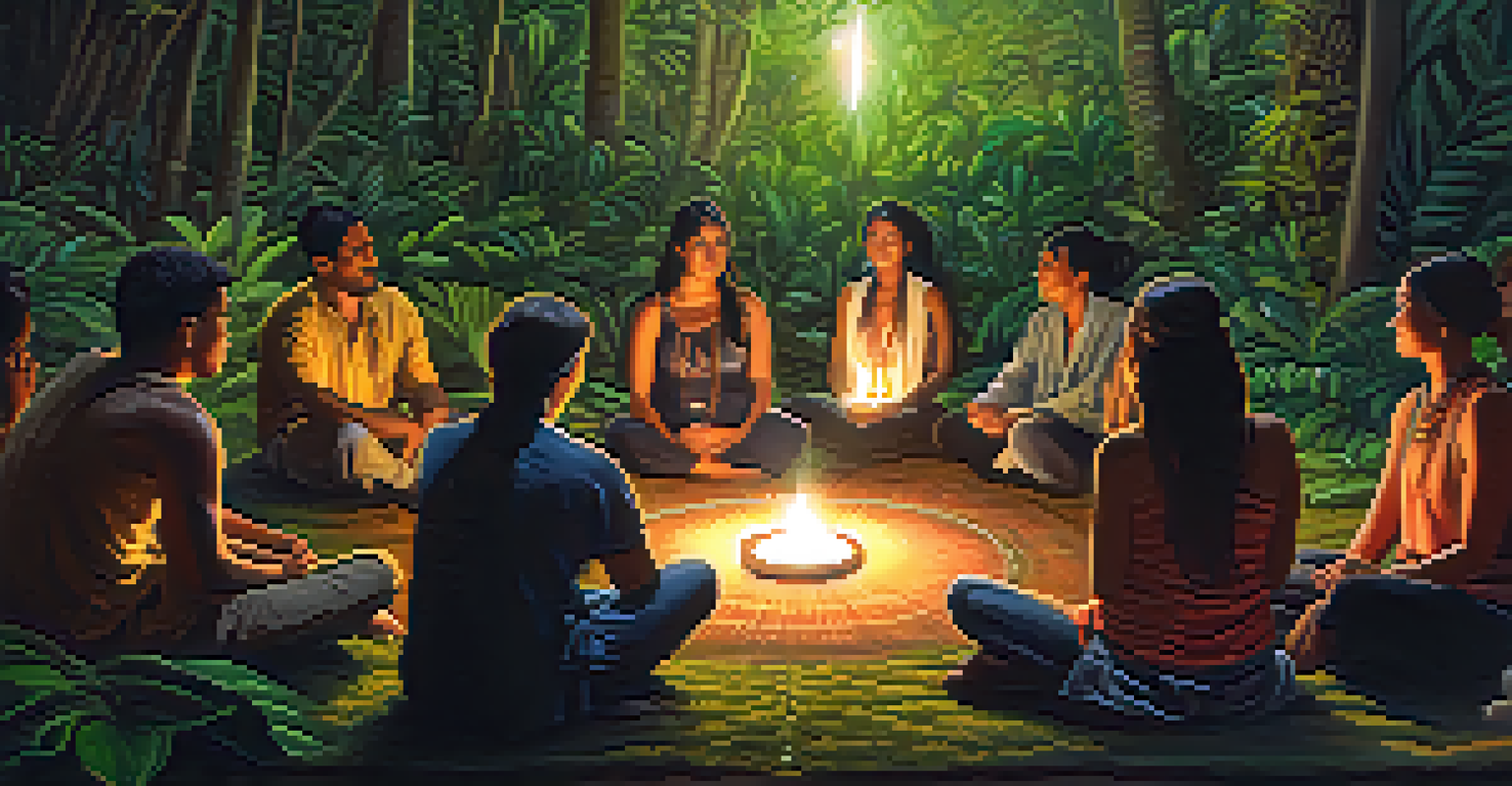The Healing Journey: Ayahuasca in Indigenous Lore

Understanding Ayahuasca: The Sacred Brew
Ayahuasca is a powerful plant medicine traditionally used by indigenous tribes in the Amazon. This sacred brew is made from the Banisteriopsis caapi vine and the Psychotria viridis leaf, creating a potent combination that induces altered states of consciousness. The experience is often described as a journey, offering deep insights and emotional healing.
The plant is a teacher. It shows you who you are and what you need to learn for your healing.
For many indigenous cultures, Ayahuasca is not just a tool for healing; it’s a spiritual ally. Shamans, or healers, guide individuals through the experience, using their knowledge of the brew’s effects to facilitate personal transformation. This relationship between the shaman and the drinker is essential for navigating the sometimes challenging visions that arise during the ceremony.
The ritual surrounding Ayahuasca is steeped in tradition, often involving singing, drumming, and other ceremonial practices. These elements create a supportive and sacred environment, allowing participants to delve deep into their psyche. The blend of nature, spirituality, and communal support amplifies the healing potential of this ancient practice.
Cultural Significance of Ayahuasca in Indigenous Traditions
In indigenous cultures, Ayahuasca is revered as a tool for communication with the spiritual world. It serves as a bridge between the physical and metaphysical realms, allowing participants to connect with ancestors and spirits. This connection is believed to provide guidance and wisdom, helping individuals navigate their life paths.

The use of Ayahuasca is often tied to cultural identity, reinforcing the values and beliefs of the community. For instance, many tribes view the journey as a rite of passage, marking significant life events such as healing from trauma or seeking clarity in decision-making. This cultural context enriches the experience, making it more than just a personal exploration.
Ayahuasca: A Path to Healing
Ayahuasca is a sacred brew used for emotional healing and spiritual growth, guided by experienced shamans.
Furthermore, Ayahuasca ceremonies foster a sense of community among participants. Sharing experiences and insights creates bonds that strengthen relationships, reinforcing the importance of social support in the healing process. This communal aspect highlights how indigenous practices view healing not just as an individual journey but as a shared experience.
The Role of the Shaman: A Guide Through the Journey
The shaman plays a crucial role in the Ayahuasca experience, acting as a spiritual guide. Their extensive training and knowledge of the brew allow them to navigate the complexities of the journey alongside participants. This guidance is vital, especially when confronting challenging visions or emotions that may arise during the ceremony.
In the depths of the soul, we find not only our pain but also our healing.
Shamans often employ traditional songs known as 'icaros' to enhance the healing process. These melodic incantations are believed to carry specific energies and intentions, helping to direct the experience and facilitate emotional release. The combination of song, ritual, and intention creates a powerful atmosphere for healing.
Moreover, the shaman serves as a protector during the journey, ensuring a safe environment for participants. Their presence is reassuring, allowing individuals to explore deep emotional and spiritual issues without fear. This trust in the shaman is a cornerstone of the Ayahuasca experience, illustrating the importance of guidance in transformative practices.
Healing Trauma: Ayahuasca’s Therapeutic Potential
Ayahuasca has gained recognition for its potential to aid in healing trauma. Many participants report profound emotional releases and insights that can help address past experiences and unresolved issues. This process often leads to a greater understanding of oneself and a sense of liberation from emotional burdens.
Research has begun to support these anecdotal claims, with studies indicating that Ayahuasca can promote neuroplasticity— the brain's ability to reorganize itself by forming new neural connections. This is particularly beneficial for individuals dealing with PTSD, depression, and anxiety, as it opens pathways for healing and personal growth.
Cultural Roots of Ayahuasca
The use of Ayahuasca is deeply tied to indigenous traditions, fostering community and personal transformation.
However, it’s essential to approach Ayahuasca with caution and respect. While many find healing, the experience can also be intense and challenging. Participants are encouraged to prepare mentally and emotionally and to seek guidance from experienced practitioners to ensure a safe and supportive environment.
The Journey Within: Personal Transformations Through Ayahuasca
Many who embark on Ayahuasca journeys report profound personal transformations. The experience often leads to a shift in perspective, allowing individuals to confront long-held beliefs and patterns. This introspection can result in a renewed sense of purpose and clarity in life.
For some, Ayahuasca reveals hidden aspects of themselves, uncovering strengths and resilience they didn’t know they had. This newfound self-awareness can empower individuals to make positive changes in their lives, whether it’s in relationships, careers, or personal well-being. The journey often catalyzes a deeper understanding of one’s connection to the universe.
Stories of transformation often highlight the integration process that follows the ceremony. Participants are encouraged to reflect on their experiences and incorporate insights into their daily lives. This integration is crucial for lasting change, emphasizing that the journey doesn’t end with the ceremony but continues as one navigates life with new awareness.
Ayahuasca in Modern Society: Bridging Tradition and Healing
As interest in Ayahuasca grows, it is increasingly finding a place in modern therapeutic practices. Many are seeking out Ayahuasca retreats and ceremonies, looking for alternative healing methods that emphasize holistic well-being. This trend highlights a broader shift towards integrating traditional wisdom into contemporary healing approaches.
However, the blending of indigenous practices with modern society raises ethical concerns. It’s crucial to honor the cultural origins of Ayahuasca and ensure that practices are respectful and not exploitative. Engaging with indigenous communities and supporting their traditions can help maintain the integrity of these sacred practices.
Modern Interest and Ethical Use
As Ayahuasca gains popularity in modern therapy, it's essential to respect its cultural origins and approach it responsibly.
Additionally, as more individuals share their experiences, there’s a growing discourse around the potential risks and benefits of Ayahuasca. Educating the public about responsible use and the importance of guided experiences is essential to ensure that this powerful medicine is approached with the respect it deserves.
Conclusion: Respecting the Ancient Wisdom of Ayahuasca
The healing journey of Ayahuasca is a profound exploration of self and spirit, deeply rooted in indigenous lore. As we navigate its complexities, it’s essential to honor the traditions and wisdom of the cultures that have used Ayahuasca for centuries. Respecting these practices ensures that future generations can benefit from this ancient medicine.
While Ayahuasca offers incredible healing potential, it is not a panacea. Each individual’s journey is unique, and personal transformation requires commitment and openness. Engaging thoughtfully with Ayahuasca can lead to significant insights and healing when approached with the right mindset.

Ultimately, the story of Ayahuasca is about connection—connection to oneself, to others, and to the world. As we continue to explore its depths, we can appreciate its role in fostering healing and understanding, bridging the ancient and modern worlds in a quest for wholeness.